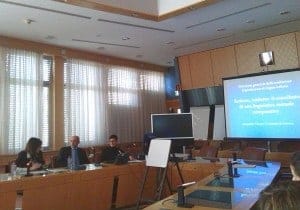 Last Tuesday, 17 March the Terminology Coordination Unit had the pleasure to host a seminar with Prof. Jacqueline Visconti from the Genoa University, organised by the Commission’s Italian Translation Department. The event aimed to provide an overview of comparative linguistics and its application to drafting and translating into Italian. Several Italian translators and terminologists from different institutions took part in it and actively joined the discussion that followed, and we believe this is a clear sign of the importance of such events since they appear to be precious occasions for experts to meet, discuss common issues, share viewpoints and keep in touch with up-to-date knowledge from the academic world.
Last Tuesday, 17 March the Terminology Coordination Unit had the pleasure to host a seminar with Prof. Jacqueline Visconti from the Genoa University, organised by the Commission’s Italian Translation Department. The event aimed to provide an overview of comparative linguistics and its application to drafting and translating into Italian. Several Italian translators and terminologists from different institutions took part in it and actively joined the discussion that followed, and we believe this is a clear sign of the importance of such events since they appear to be precious occasions for experts to meet, discuss common issues, share viewpoints and keep in touch with up-to-date knowledge from the academic world.
The seminar started with an introductory speech by Katia Castellani, Training Correspondent of the Italian Translation Dept. in Luxembourg, and Rodolfo Maslias, head of the Terminology Coordination Unit of the European Parliament. They both underlined the key role of the REI, the Commission’s network of language professionals engaged in improving the linguistic quality of institutional texts produced in Italian. They also emphasised the crucial importance for the European institutions to adopt an established terminology with the aid of CAT tools, especially in normative texts. Indeed, together with ambiguity, this was the main topic of Prof. Visconti’s seminar.
 In the first part of the talk she outlined the central concepts of text linguistics: from decoding and interpretation to the different levels of text analysis, including detailed aspects such as problematic connectives and punctuation, which are key elements to understand how the information is structured and interconnected, especially in normative texts where ambiguity can have serious legal consequences. Visconti also focused on the importance of the extra-linguistic information, i.e. the co-text and our encyclopaedia of knowledge, which allow us to interpret literal meanings through the principle of coherence. The theoretical contents were wisely supported by a varied series of quotes from linguists and translation experts such as E. Jamrozik, B. Terracini, D. Cosmai, M. E. Conte, A. Ferrari and L. Allen, but also from renowned thinkers such as Fr. Schleiermacher and B. Croce, and law experts such as N. Bobbio.
In the first part of the talk she outlined the central concepts of text linguistics: from decoding and interpretation to the different levels of text analysis, including detailed aspects such as problematic connectives and punctuation, which are key elements to understand how the information is structured and interconnected, especially in normative texts where ambiguity can have serious legal consequences. Visconti also focused on the importance of the extra-linguistic information, i.e. the co-text and our encyclopaedia of knowledge, which allow us to interpret literal meanings through the principle of coherence. The theoretical contents were wisely supported by a varied series of quotes from linguists and translation experts such as E. Jamrozik, B. Terracini, D. Cosmai, M. E. Conte, A. Ferrari and L. Allen, but also from renowned thinkers such as Fr. Schleiermacher and B. Croce, and law experts such as N. Bobbio.
The second part provided a fine-grained analysis of a set of legal texts, including Italian laws and sentences as well as EU legislation. This showed how a comparative textual approach can contribute to increase the quality of both drafting and translation and help avoid ambiguity. As a matter of fact, most of the problems that translators have to face in this type of texts are due to the fact that when it comes to draft a text, legal experts are not always aware of the specific inferences and deconding processes produced by specific connectors, prepositions and punctuation. This is what emerges from a linguistic analysis of many Italian laws, where ambiguity can even be intentionally generated as a mean to exercise political power. Ambiguity, however, can also be found in many normative texts of the EU institutions, where it happens that the meaning of a sentence can change completely from one language to the other just due to a different connector or verb. To give an example, the English verb shall can have both a prescriptive and performative function and is one of the most ambiguous words in legislative drafting. A case of good practice comes from the Government of the UK, which has provided a guide for alternative expressions, including those to be avoided. Unfortunately, this word is still widely used in the EU legislation and, despite the fact that the European institutions promote quality controls on their normative documents, it still seems that no concrete action is being taken to resolve the major issue of ambiguity and inconsistent terminology.
The key conclusion to this seminar was that the translators’ contribution is fundamental in the process of raising awareness of the need to adopt good linguistic practice among legal experts and institutions drafting normative texts.
Jacqueline Visconti, University of Genoa
Her main area of research concerns comparative analysis of legal texts and legal translation within the EU context, as reflected in her participation in the Rete di Eccellenza dell’Italiano Istituzionale (European Commission), the Società Italiana per la Ricerca in Diritto comparato, the Verein zur Förderung der Europäischen Rechtslinguistik and in her publications in the past twelve years.
By Cristina Pagliuca
Translation and terminology expert
Trainee at the Terminology Coordination Unit
